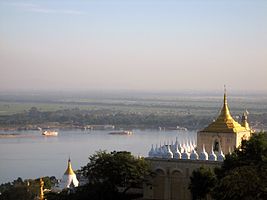
The Ayeyarwady River or Irrawaddy River is a river that flows from north to south of Burma (Myanmar). It is the country's largest river (about 1350 miles or 2170 km long) and its most important commercial waterway, with a drainage area of about 158,700 square miles (411,000 km²).
Etymology
The Myanmarese name of Ayeyarwady (formerly transliterated as Irrawaddy) is derived from the ancient name of the river Ravi, Airavati, in the Punjab region, but through it's Pali, rather than its Sanskrit form. Airavati in turn is the name of the elephant mount of Indra, a minor Indian goddess. Elephants were in Indian mythology often a symbol for water
When transliterated literally from Myanmar spelling, the modern rivername comes down to Erawati. Due to the spreading of Buddhism in South-East Asia, some names in Myanmar, and to a lesser extent in other South-East Asian countries, are adaptations of Indian place names associated with Buddhism, e.g. Myawaddy (originated from Amaravati), Dvaravati, Ayuthia (originated from Ayoddhya or Ayujjha), Cambodia (originated from Kamboja). Erawati also belongs to this category, as it is also the ancient name of the river Ravi in Punjab". The ancient name was Airavati, in Sanskrit meaning
- ira -any drinkable fluid; a draught (especially of milk),...food, refreshment, ..vat...granting drink or refreshment,...name of a river in Panjab now called Ravi..
- Airavata (fr.ira-vat), a descendant of Ira-vat;....,N. of Indra’s elephant...(i) the female of Indra’s elephant; N. of a river,...;lightning...."
This is incompatible with Erawati, as it does not start with the vowel e. When the ancient name of the Ravi is rendered in Romanised Pali though, it is Eravati, which is compatible with the modern transliteration of the rivername, Erawati. The above means that not influence by Arabic (via Wadi), or Sanskrit (via Airavati) but Pali (via Eravati) has determined the name of the Irrawaddy.
The Irrawaddy gives its name to a dolphin, the Irrawaddy dolphin (Orcaella brevirostris), which is found in the upper reaches of the river and known to help fishermen who practice cast-net fishing. Though sometimes called the Irrawaddy River Dolphin, it is not a true river dolphin, since it is also found at sea.
[edit] Physiography
The Ayeyarwaddy River bisects the country from north to south and empties through a nine-armed Irrawaddy Delta into the Indian Ocean.
[edit] Source
It arises by the confluence of the N'mai and Mali Rivers in Kachin State Kachin. Both the N'mai and Mali Rivers find their sources in the Himalaya glaciers of Northern Myanmar, in the vicinity of 28° N . The eastern branch of the two, N'mai river, is the larger stream, but it is unnavigable because of the strong current whereas the smaller western branch, the Mali river, is navigable, despite a few rapids.
The town of Bhamo, about 150 miles (240 km) south of the Mali and N'mai river confluence, is the northernmost city reachable by boat all the year round although during the monsoons most of the river cannot be used by boats. The city of Myitkyina however lies 30 miles (48 km) south of the confluence and can be reached during the dry season.
Defiles
Between Myitkyina and Mandalay, the Irrawaddy flows through three well-marked defiles[11] :
- About 40 miles (65 km) downstream from Myitkyinā is the first defile.
- Below Bhamo the river makes a sharp westward swing, leaving the Bhamo alluvial basin to cut through the limestone rocks of the second defile. This defile is about 300 feet (90 m) wide at its narrowest and is flanked by vertical cliffs about 200 to 300 feet (60 to 90 metres) high.
- About 60 miles (100 km) north of Mandalay, at Mogok, the river enters the third defile. Between Katha and Mandalay, the course of the river is remarkably straight, flowing almost due south, except near Kabwet[12], where a sheet of lava has caused the river to bend sharply westward.
This sheet of lava is the Singu Plateau, a volcanic field from the Holocene. This field exists of magma from the fissure vents and cover an area of about 62 km². The plateau is also known as Letha Taung.
Leaving this plateau at Kyaukmyaung, the river follows a broad, open course through the central dry zone - the ancient cultural heartland — where large areas consist of alluvium flats. From Mandalay (the former capital of the kingdom of Myanmar), the river makes an abrupt westward turn before curving southwest to unite with the Chindwin River, after which it continues in a southwestern direction. It is probable that the upper Irrawaddy originally flowed south from Mandalay, discharging its water through the present Sittoung River to the Gulf of Martaban, and that its present westward course is geologically recent. Below its confluence with the Chindwin, the Irrawaddy continues to meander through the petroleum producing city of Yenangyaung, below which it flows generally southward. In its lower course, between Minbu and Prome, it flows through a narrow valley between forest-covered mountain ranges—the ridge of the Rakhine Yoma Mountains to the west and that of the Pegu Yoma Mountains to the east














0 comments:
Post a Comment